

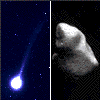 Small Bodies
Small Bodies
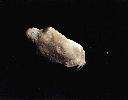 Ida and Dactyl
Ida and Dactyl
This color mosaic shows the asteroid Ida and its newly-discovered moon, Dactyl. The images were taken by the camera system on the Galileo spacecraft, about 14 minutes before its closest approach to the asteroid on August 28, 1993. Ida appears to be about 52 km (32 mi) in length and is irregularly shaped. This view shows numerous craters, including many degraded craters, indicating Ida's surface is older than previously thought.
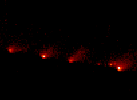
 Comet Fragments
Comet Fragments
This Hubble Space Telescope mosaic of comet Shoemaker-Levy 9 was taken on May 17, 1994, with the Wide Field Planetary Camera. When the comet was observed, its train of 21 icy fragments stretched across 1.1 million km (710 thousand mi) of space. In this view the comet was approximately 660 million km (410 million mi) from Earth, on a mid-July collision course with the planet Jupiter. Scientists labelled the nuclei using letters of the alphabet; the subsequent collisions with Jupiter were identified according to those letters.
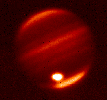
 Impact G
Impact G
A near-infrared image of Jupiter shows the G and D impact sites as a single bright cloud over 14,000 km (8680 mi) in diameter. The image was taken through the 3.5-meter telescope at Apache Point Observatory in New Mexico on July 19, 1994.
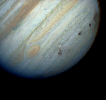
 Multiple Impacts
Multiple Impacts
This image of Jupiter was obtained by the Hubble Space Telescope's Wide Field Planetary Camera after numerous fragments of comet Shoemaker-Levy 9 had collided with the planet. Eight impact sites are visible. From left to right are the E/F complex (barely visible on the edge of the planet), the star-shaped H site, the impact sites for tiny N, Q1, small Q2, and R, and on the far right limb the D/G complex. The smallest features in this image are less than 200 km (124 mi) across.
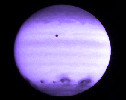
 Impacts in UV
Impacts in UV
This ultraviolet image taken from the Hubble Space Telescope shows Jupiter's atmosphere after many impacts by fragments of comet Shoemaker-Levy 9. A large, dark patch from the impact of fragment H is visible rising on the left side. Proceeding to the right, other dark spots were caused by impacts of fragments Q1, R, D and G, and L, with L covering the largest area of any seen thus far. The spots are very dark in the ultraviolet because a large quantity of dust is being deposited high in Jupiter's stratosphere, and that dust absorbs sunlight. Scientists will be able to track winds in the stratosphere by watching the evolution of these features. Jupiter's moon, Io, is the dark spot just above the center of the planet.
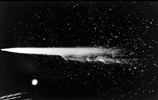
 Halley in 1910
Halley in 1910
This historic photograph shows a wide-angle view of Halley's Comet as it appeared over Flagstaff, Arizona on May 13, 1910. The streaks at lower left are the city lights of Flagstaff, and the large bright object below the comet is the planet Venus. The best known of all comets, Halley orbits the Sun, and travels close enough to be seen from the Earth approximately once every 75 years. Its appearances have been recorded at least 30 times over the past 2000 years, and scientists have accurately predicted its return starting with its appearance in 1758.
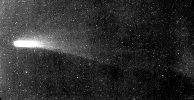
 Ion Tail
Ion Tail
The well-developed tail structure of Comet Halley was captured in this image taken March 5, 1986. At this point in its orbit, Halley had recently passed perihelion on February 9, 1986 and was at its most active. This 10-minute exposure was recorded at Mauna Kea Observatory on IIIa-J emulsion without filters. This image shows both the ion and dust tail, with the latter stretching for over 6 degrees on the sky.
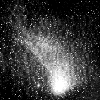
 Detachment Event
Detachment Event
One of the more spectacular changes recorded for Halley during an apparition was the detachment event that happened April 12, 1986. This 3-minute exposure was taken using the Michigan Schmidt telescope at Cerro Tololo Interamerican Observatory. The resulting image clearly shows part of the ion tail structure detached from the comet. At this period, the orientation of the comet is such that the tail is foreshortened, with the prolonged radius vector pointing west of north.
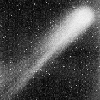
 Ray Structure
Ray Structure
An example of the ray structure of Halley was captured on March 19, 1986, at the Mount Wilson/Las Campanas Observatories. This 10-minute exposure was recorded at the focus of the 100-inch telescope on Las Campanas in Chile. The close-up image, covering the inner 1 degree of the comet, shows a prolonged radius vector extending to the left.
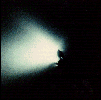
 Halley Close-Up
Halley Close-Up
This dramatic image shows the nucleus of Halley's Comet and the surrounding coma as viewed by the Halley Multicolor Camera on the Giotto spacecraft. The fan-shaped set of streamers extending toward the sun from the coma is composed of dust jets being blown off the comet's nucleus by the sublimation of its ices. The Giotto spacecraft was approximately 25,600 km (15,800 mi) from the comet when this image was taken in March, 1986. Giotto was sent by the European Space Agency to observe the comet.
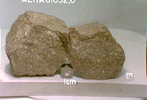
 Chondrite Meteorite
Chondrite Meteorite
This meteorite was collected from the Allan Hills in Antarctica. Meteorites are bits of rock that are captured by a planet's gravity and pulled to the surface. This meteorite is of a type named chondrite and is thought to have formed at the same time as the planets in the solar nebula, about 4.55 billion years ago.
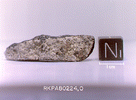
 Achondrite Meteorite
Achondrite Meteorite
Discovered at Reckling Peak, Antarctica, this type of meteorite is known as an achondrite. It has a basaltic composition and was probably formed when an asteroid melted about 4.5 billion years ago. The asteroid broke up some time later and this small piece of the asteroid was captured by Earth's gravity and fell to the ground.
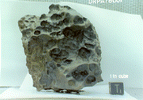
 Iron Meteorite
Iron Meteorite
This iron meteorite was found at Derrick Peak, Antarctica. This type of meteorite gets its name because it is mostly made of the elements iron and nickel. This sample is probably a small piece from the core of a large asteroid that broke apart.
